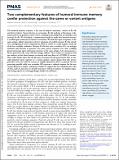| dc.contributor.author | Van Beek, Matthew | |
| dc.contributor.author | Nussenzweig, Michel C | |
| dc.contributor.author | Chakraborty, Arup K | |
| dc.date.accessioned | 2024-12-09T21:18:19Z | |
| dc.date.available | 2024-12-09T21:18:19Z | |
| dc.date.issued | 2022-09-13 | |
| dc.identifier.uri | https://hdl.handle.net/1721.1/157803 | |
| dc.description.abstract | The humoral immune response, a key arm of adaptive immunity, consists of B cells and their products. Upon infection or vaccination, B cells undergo a Darwinian evolutionary process in germinal centers (GCs), resulting in the production of antibodies and memory B cells. We developed a computational model to study how humoral memory is recalled upon reinfection or booster vaccination. We find that upon reexposure to the same antigen, affinity-dependent selective expansion of available memory B cells outside GCs (extragerminal center compartments [EGCs]) results in a rapid response made up of the best available antibodies. Memory B cells that enter secondary GCs can undergo mutation and selection to generate even more potent responses over time, enabling greater protection upon subsequent exposure to the same antigen. GCs also generate a diverse pool of B cells, some with low antigen affinity. These results are consistent with our analyses of data from humans vaccinated with two doses of a COVID-19 vaccine. Our results further show that the diversity of memory B cells generated in GCs is critically important upon exposure to a variant antigen. Clones drawn from this diverse pool that cross-react with the variant are rapidly expanded in EGCs to provide the best protection possible while new secondary GCs generate a tailored response for the new variant. Based on a simple evolutionary model, we suggest that the complementary roles of EGC and GC processes we describe may have evolved in response to complex organisms being exposed to evolving pathogen families for millennia. | en_US |
| dc.language.iso | en | |
| dc.publisher | Proceedings of the National Academy of Sciences | en_US |
| dc.relation.isversionof | 10.1073/pnas.2205598119 | en_US |
| dc.rights | Creative Commons Attribution-NonCommercial-NoDerivs License | en_US |
| dc.rights.uri | https://creativecommons.org/licenses/by-nc-nd/4.0/ | en_US |
| dc.source | Proceedings of the National Academy of Sciences | en_US |
| dc.title | Two complementary features of humoral immune memory confer protection against the same or variant antigens | en_US |
| dc.type | Article | en_US |
| dc.identifier.citation | M. Van Beek, M.C. Nussenzweig, A.K. Chakraborty, Two complementary features of humoral immune memory confer protection against the same or variant antigens, Proc. Natl. Acad. Sci. U.S.A.119 (37) e2205598119. | en_US |
| dc.contributor.department | Massachusetts Institute of Technology. Department of Physics | en_US |
| dc.contributor.department | Massachusetts Institute of Technology. Department of Chemistry | en_US |
| dc.contributor.department | Massachusetts Institute of Technology. Institute for Medical Engineering & Science | en_US |
| dc.contributor.department | Ragon Institute of MGH, MIT and Harvard | en_US |
| dc.relation.journal | Proceedings of the National Academy of Sciences | en_US |
| dc.eprint.version | Final published version | en_US |
| dc.type.uri | http://purl.org/eprint/type/JournalArticle | en_US |
| eprint.status | http://purl.org/eprint/status/PeerReviewed | en_US |
| dc.date.updated | 2024-12-09T21:09:55Z | |
| dspace.orderedauthors | Van Beek, M; Nussenzweig, MC; Chakraborty, AK | en_US |
| dspace.date.submission | 2024-12-09T21:09:56Z | |
| mit.journal.volume | 119 | en_US |
| mit.journal.issue | 37 | en_US |
| mit.license | PUBLISHER_CC | |
| mit.metadata.status | Authority Work and Publication Information Needed | en_US |
